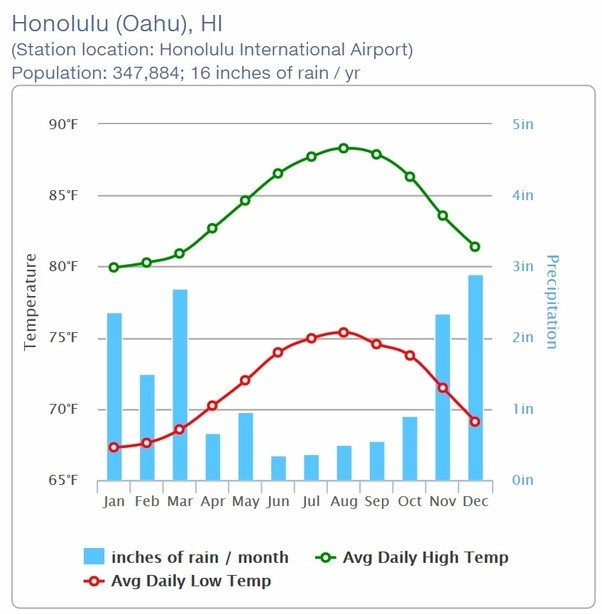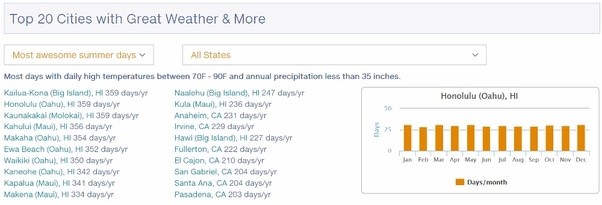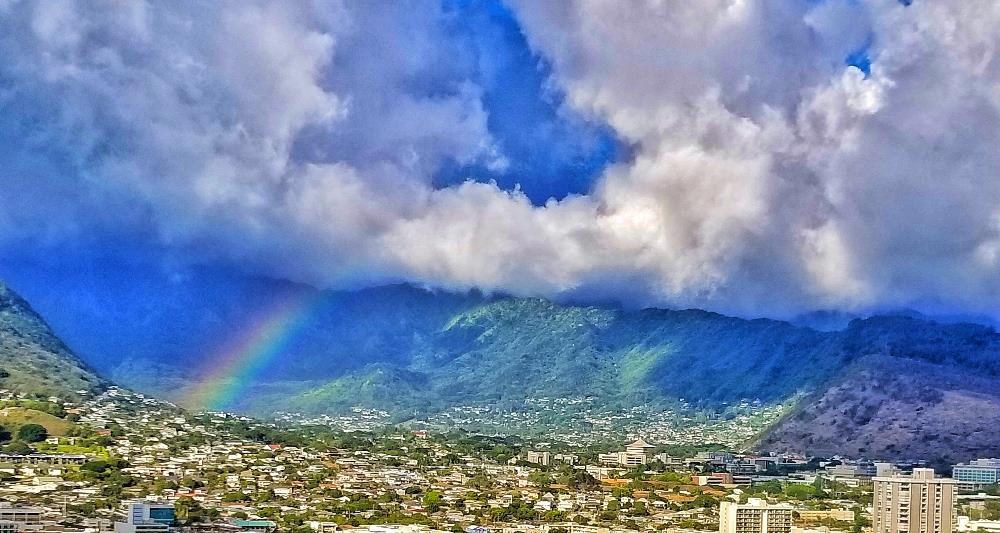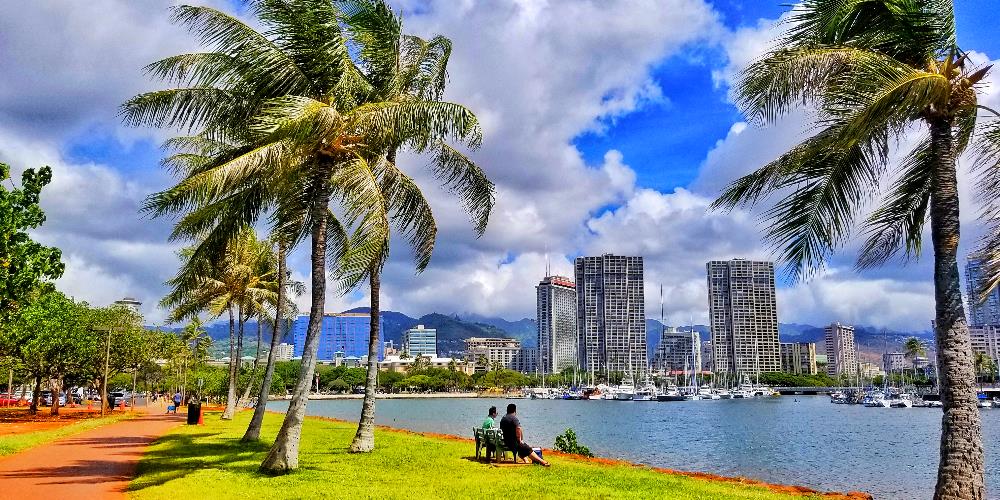There is no place on earth that has better weather than Hawaii.
The air feels like silk the moment you get off the plane. Shorts and T-shirts serve you well all year long – day and night. Many of my clients select Honolulu as their home because of the perfect year-round climate and their improved lifestyle and well-being. This is the sweet zone to maximize life and outdoor enjoyment.
Some of my friends and clients report that their health improves when spending time in Hawaii. They report relief from sinus pressure, asthma, respiratory ailments, bronchitis, coughing and sleep deprivation.
These benefits could be attributed to our fresh sea air packed with negative hydrogen-ion charged particles that help absorb oxygen and neutralize damaging free radicals. Negative ions help balance serotonin levels, thus improving mood, alertness, and quality of sleep.
The air quality in Honolulu and Hawaii consistently ranks as the best in the nation. We have it good in Hawaii.
The Economist’s Global Liveability Report 2017 ranks Honolulu as America’s most livable city, based on many factors including health care, environment, infrastructure and overall stability.
In September 2017, WalletHub ranked Hawaii as the 3rd happiest state in the nation. Hawaii took the top spot in the emotional & physical well-being subcategory.
In October 2017, National Geographic ranked urban Honolulu #15 out of 190 U.S. metro areas in their most recent survey of the happiest cities in the U.S.
It is no wonder that Hawaii claims the top spot for life expectancy in the US. Scientists believe our genes determine about 30% of our longevity. The two remaining factors are 1) lifestyle choices and 2) living environment. Both of these factors are entirely within your control and closely related to the weather where you live.
I can’t promise what living in Hawaii might do for you, but I know it has done wonders for me and others. What better than ideal year-round weather to promote an active outdoor lifestyle? Perhaps it is time for you to pick your desired lifestyle and perfect weather. Consider living in Hawaii.
Let’s explore what makes Hawaii’s weather special and how you can select the right neighborhood with its unique microclimate. Yes, you read it right. I’m suggesting that you consider microclimates when selecting your neighborhood. But before we get to neighborhood microclimates, let’s understand what makes Hawaii’s climate the finest on the entire planet.
1) Unique Maritime Climate Conditions
There is no other major population center in the world that is surrounded by more ocean water than Honolulu. This vast ocean brings unique maritime climate benefits.
Hawaii’s surrounding open ocean surface water temperatures range between 77 *F (25*C) in March and 83*F (28*C) in late September. The stable ocean water temperature minimizes Hawaii’s daily temperature swings.
Honolulu’s summer temperatures at sea level are balmy and warm but never hot, averaging 88*F (31*C) at day and 75*F (24*C) at night.
Honolulu’s winter temperatures at sea level are comfortable but never cold, averaging 83*F (28*C) during the day and hardly ever dipping below 65*F (18*C) at night.
No other place in the entire world has this narrow range of temperatures.

Compare Hawaii’s temperate climate with climates of other world locations at similar 20 degree north latitudes, e.g., Hong Kong, Mecca, Sahara Desert and Mexico City, and it is easy to see what I mean.
2) Tropical Latitude
Hawaii’s proximity to the equator results in a relatively equal length of daylight and night time. This consistency throughout the year, with only minimal changes of the sun’s angle above the horizon, creates a steady inflow of solar energy.
Following is a list of the top 20 US cities with the most awesome summertime daily high temperatures between 70F – 90F and annual precipitation of less than 35 inches. 13 of the top 20 cities are in Hawaii:

Check this interactive US weather map and compare your city with Honolulu and 25 other Hawaii cities. Pick the one that suits you best.
3) Soothing trade winds due to the Coriolis Effect
Besides steady sunlight and temperatures, Hawaii enjoys a unique north-easterly trade wind pattern with 5 to 15 miles per hour winds prevailing 90% of the time. Our trade winds are the result of the Coriolis effect in a band north of the equator up to ~30*north latitude. Hawaii’s trade winds bring a constant flow of fresh temperate air traveling for thousands of miles over tropical ocean waters, naturally cooling the islands and providing the cleanest air anywhere on the planet. It is the combination of the above three factors that create Hawaii’s gently soothing climate. But there is more!
4) Oceans meet tall mountains creating rainbows
Where tropical oceans meet tall mountains in Hawaii, cloud formation and rain create variations in the local weather. The mountain elevation affects temperatures, and the size and shape define rainfall patterns. When Hawaii’s warm and humid trade winds reach the eastern shores, known as the ‘Windward’ side of each island, the moist air gets pushed up the mountains and cools at higher elevations. Clouds typically form between 1,000 to 4,000 ft elevation, often covering the mountain summits. You can watch the clouds accumulating in front of the mountains on the Windward side of the islands, dance around the mountain tops, and eventually fizzling away on the western ‘Leeward’ side into sunny blue skies. It is a remarkable sight to watch. Frequent rain showers in the mountains and in the back of the valleys create lush green foliage and replenish the watershed, our source of some of the best lava rock filtered, mineral-rich drinking water in the world.

We call light rain showers ‘liquid sunshine’, frequently creating perfect rainbows and even double rainbows. The cloud that caused the shower may no longer be visible by the time you look up, already dissipated and giving way to a perfect blue sky.
In general, Hawaii’s consistent easterly trade winds in combination with each island’s mountain range result in sunny and dry ‘Leeward’ sides and south shores, in contrast to the more cloudy and rainy, green ‘Windward’ sides of the islands.
The majority of Hawaii’s population lives in these two climate zones, mostly along the coastal regions and rarely above 1,000 feet elevation. These two popular climate zones correlate with the following two zones of the Koppen Climate Classification System:
- Hot Semi-Desert (BSh), Hawaii’s most populated climate zone includes all of Oahu’s southern shore with Honolulu, Waikiki, Ewa Plain with Kapolei, and Oahu’s leeward side. Zone Bsh can also be found in the popular resort areas along Maui’s Kaanapali Coast, Kauai’s Poipu Beach, and Big Isle’s Kailua Kona.
This is my favorite climate zone. I call this perfect paradise weather. Warm and dry with plentiful blue skies. If you prefer it a little cooler, consider moving to a slightly higher elevation. You might find Honolulu’s ocean view homes and neighborhoods appealing, offering an excellent blend of closeness to Honolulu’s urban core, with slightly cooler temperatures due to the elevation, and mesmerizing ocean views. We will explore these neighborhoods shortly. - Tropical Rainforest (Af), Hawaii’s second most populated climate zone can be found on the windward side of Oahu, including Kailua, Kaneohe, as well as the windward coasts of the other Hawaiian islands. Warm paradise weather but more humid with increased rainfall creating lush green vegetation.
You have choices. Decide which variation of paradise weather suits you best. But there is more to both climate zones. Let’s analyze some of the microclimates of Oahu’s popular neighborhoods.
5) Choose your perfect microclimate when selecting Oahu’s popular neighborhoods
Between Oahu’s two climate zones, Hot Semi-Desert (BSh) and Tropical Rainforest (Af), there are several microclimate variations. Consider the following three factors when selecting your favorite Oahu neighborhood to live:
- Proximity to the mountains: The closer you are to the mountains, the more likely you will encounter clouds and rain. Often you will find clouds around the mountain tops with rainfall deep in the back of the valleys, versus blue sky and sunshine towards the front of the same valley. The difference between rain and sunshine could be a mere half a mile distance. Consider this when selecting most of Oahu’s valley neighborhoods, including Hahaione Valley, Kuliouou Valley, Niu Valley, Aina Haina Valley, Palolo Valley, Manoa Valley, Nuuanu, and Dowsett with Old Pali.
- Elevation: If you prefer cooler temperatures, consider some elevated neighborhood locations. 1,000 ft (~300 m) elevation translates into a 3.5*F (1.94*C) drop in temperature, typically with an increase in cloud cover. Consider this when selecting Oahu’s elevated neighborhoods, including Napali Haweo, Mariners Ridge, Hawaii Loa Ridge, Kahala Kua, Waialae Iki, Waialae Nui Ridge, Wilhelmina Rise and Maunalani Heights, St. Louis Heights, Makiki Heights, Tantalus, Pacific Heights, Aiea Heights, Makakilo, and Pupukea on Oahu’s North Shore.
- Orientation in relation to the trade winds: Living in elevated neighborhoods can increase the intensity of our beloved trade winds, especially along the east facing side of the ridge locations. The orientation towards or away from the trade winds can make the difference between being able to enjoy your pool and reading a newspaper on your lanai, or not. Consider west facing ridge locations if you like to minimize the trade winds on your outdoor entertainment areas. This applies to all elevated Oahu neighborhoods.
6) More choices: The Big Island with 10 out of 14 climate zones
You are now an expert in selecting the ideal microclimate for some Oahu neighborhoods to optimize your life quality. Pick the variation of perfect weather that suits you best.
In case you feel adventurous and you seek more climate variety, consider a 45-minute flight from Honolulu to the Big Island of Hawaii. Here you find 10 of 14 climate zones and subcategories of the original Koppen Climate Classification System, all within 4,028 sq. miles. That is a remarkable statistic.
There is no other place in the world where you can experience ten climate zones during a day trip around the Big Island of Hawaii. From Hot Desert (BWh) to Periglacial Climate (ET). If you have the urge to go snowboarding, you may do so on the 13,796 ft (4,250 m) Mauna Kea mountaintop. Who needs to fly to Switzerland or Colorado?
— All of Hawaii’s weather options are amazing. We truly live in Paradise. – You only live once. Choose the world you want to live in and optimize your life.
We love to hear from you. Let us know your thoughts. Reciprocate Aloha! ‘Like’, ‘Share’ and ‘Comment’ below.
~ Mahalo & Aloha

Found this in 2024, still very useful as I was explaining it to a visitor!
My wife and I are visiting from Japan and were wondering why the climate is so comfortable in Hawaii. Your article provided a very clear and readable explanation. You do indeed live in paradise. Thank you!
Aloha Vik!
Thank you for your kind words.
Make this your best vacation ever.
We are fortunate indeed.
~ Mahalo & Aloha
Thank you so much for writing this article, you just helped a 6th grader with his virtual science test questions on climate in h
Hawaii. Aloha from Oklahoma!
Aloha Amanda!
We are delighted to hear that.
~ Mahalo & Aloha
Nice, I visited Hawaii last Febuary and l like the weather. I’m moving to Cairns in Queensland Australia from Adelaide. Cairns has similar weather as Hawaii.
Aloha Plas Matta!
Congratulations! Stay safe.
~ Mahalo & Aloha
Awesome description of my new home state last 13 years. We live on the ocean at makaha surfside. The best condo I have ever seen on Oahu. A Lagoon 2 pools, 2 laundry mats on property. A store, weight room and sauna, covered parking garage for year round walk abouts out of the rain and protection from high water and mountain flooding.
Aloha Tommy Holloman!
Thank you for your comment and congratulations on having properly designed your lifestyle, ..on the sunny side.
Let us know if there is anything else we can do for you.
We are here to help.
All the Best. ~ Mahalo & Aloha
Very informative, George. Thanks a lot!
Aloha Bonny Buckley!
Thank you for your comment.
Let us know if there is anything we can do for you.
We are here to help.
~ Mahalo & Aloha